Cloud and Aerosol Impacts on the Radiation Budget over China from 2000 to 2023
Abstract
1. Introduction
2. Materials and Methods
2.1. Data Description
2.1.1. Ground-Based Radiation Observations
2.1.2. Radiation from Satellite and Reanalysis Datasets
2.1.3. Satellite Products for Cloud and Aerosol Properties
2.2. Data Processing
2.2.1. Clouds and Aerosols Radiation Calculations
2.2.2. Evaluation Metrics
3. Results
3.1. Validation of Satellite and Reanalysis Radiation
3.2. Radiative Flux Variations in China
3.3. Cloud Radiative Effects and Cloud Characteristics in China
3.4. Aerosol Radiative Effects and Aerosol Properties in China
4. Discussion
5. Conclusions
- (1)
- Validation of Radiation Data Products in China: By comparing the surface solar radiation from CMA ground-based stations with satellite-derived products (CERES-SYN, CERES-EBAF, GEWEX-SRB, ISCCP-FH) and reanalysis datasets (ERA5 and MERRA-2), this study finds that CERES-SYN product has reasonable agreement with CMA data, and it is well suited for further analysis over China.
- (2)
- Cloud Radiative Effects and Cloud Properties: The multi-year averaged NET CRE over China is −23.17 W m−2, which weakens with increasing latitude. The CRE is primarily driven by the scattering of SW radiation, while LW absorption compensates for the NET radiation in certain regions. In southern China, the high CRE is mainly due to high CF and COD of mid-HC and mid-LC, along with the smaller cloud water and ice particle radius. Over Tibetan Plateau, CRE is mainly affected by the high CF and COD of mid-HC and the smaller ice particle sizes. In contrast, northern regions such as Xinjiang and Inner Mongolia exhibit a weaker CRE cooling due to lower CF, smaller COD, and larger cloud particle sizes.
- (3)
- Aerosol Radiative Effects and Aerosol Properties: Aerosols exert an overall cooling effect under both clear-sky and all-sky conditions, which result from a strong SW cooling effect and a slight LW warming effect. The NET ARE at both TOA and SFC is primarily influenced by SW radiation and generally exhibits negative values and apparent regional variations. In southern China, ARE is largely driven by SO4 and OC, whereas in northern China, it is influenced by a combination of SO4, DU, and OC. In northwest China and the Tibetan Plateau, DU is the dominant contributor, while in coastal regions, sea salt plays a major role.
- (4)
- Influence of Clouds and Aerosols on Radiation Changes in China: From March 2000 to February 2023, decreases in the net radiative fluxes over China at the top of the atmosphere (at −0.38 W m−2 year−1) and the surface (at −0.35 W m−2 year−1) during the study period has been observed. The different radiation variation trends at the SFC and TOA in different regions reveals that cloud and aerosol variations are important to explain the disparities. In southern China, reductions in OC and BC weaken the aerosol cooling effect, while the CRE effects are complex due to the combined influence of mid-HC, mid-LC, and LC clouds. In northern China, aerosol reductions in OC and DU drive the radiative flux changes, and decreases in mid-LC and LC clouds further diminish the CRE cooling. Over the Tibetan Plateau, the decrease in mid-HC CF and COD drives the radiation changes. In Xinjiang, increases in HC and mid-HC CF, and DU aerosol contribute to radiative flux changes, though their overall impacts are relatively small. In Inner Mongolia, the weakening of the CRE cooling is linked to reductions in mid-LC CF and COD, while decreases in DU and SO4 further weakened the aerosol cooling effect. Overall, while aerosol radiative effects dominate radiative flux changes across China, the complex variations in cloud properties, particularly the influence of different cloud layers in southern China, also play a crucial role and should not be overlooked.
- (5)
- Challenges and Limitations: First, uncertainties in the estimation of aerosol properties from the MERRA-2 dataset, particularly the potential biases in AOD and composition retrievals, highlight the necessity for further refinement and independent validation of aerosol datasets over China. Second, although this study reveals regional disparities in the influences of aerosols and clouds on radiative flux variations, the effects of post-2013 anthropogenic emission reductions on aerosol radiative effects, as well as their spatial manifestations, require more comprehensive investigation. Finally, advancing the understanding of how aerosols and clouds influence regional and large-scale radiation budgets, thereby affecting climate processes, remains a critical challenge.
Supplementary Materials
Author Contributions
Funding
Data Availability Statement
Conflicts of Interest
References
- Stephens, G.L. An Update on Earth’s Energy Balance in Light of the Latest Global Observations. Nat. Geosci. 2012, 5, 691–696. [Google Scholar] [CrossRef]
- Wild, M. The Global Energy Balance as Represented in CMIP6 Climate Models. Clim. Dyn. 2020, 55, 553–577. [Google Scholar] [CrossRef]
- Wild, M. Towards Global Estimates of the Surface Energy Budget. Curr. Clim. Chang. Rep. 2017, 3, 87–97. [Google Scholar] [CrossRef]
- Wild, M.; Folini, D.; Schär, C.; Loeb, N.; Dutton, E.G.; König-Langlo, G. The Global Energy Balance from a Surface Perspective. Clim. Dyn. 2013, 40, 3107–3134. [Google Scholar] [CrossRef]
- Trenberth, K.E.; Fasullo, J.T.; Kiehl, J. Earth’s Global Energy Budget. Bull. Amer. Meteor. Soc. 2009, 90, 311–324. [Google Scholar] [CrossRef]
- Beer, J.; Mende, W.; Stellmacher, R. The Role of the Sun in Climate Forcing. Quat. Sci. Rev. 2000, 19, 403–415. [Google Scholar] [CrossRef]
- Gray, L.J.; Beer, J.; Geller, M.; Haigh, J.D.; Lockwood, M.; Matthes, K.; Cubasch, U.; Fleitmann, D.; Harrison, G.; Hood, L.; et al. Solar Influences on Climate. Rev. Geophys. 2010, 48, RG4001. [Google Scholar] [CrossRef]
- Kiehl, J.T.; Trenberth, K.E. Earth’s Annual Global Mean Energy Budget. Bull. Amer. Meteor. Soc. 1997, 78, 197–208. [Google Scholar] [CrossRef]
- Wild, M. Global Dimming and Brightening: A Review. J. Geophys. Res. 2009, 114, D00D16. [Google Scholar] [CrossRef]
- Stephens, G.L.; O’Brien, D.; Webster, P.J.; Pilewski, P.; Kato, S.; Li, J. The Albedo of Earth. Rev. Geophys. 2015, 53, 141–163. [Google Scholar] [CrossRef]
- Ramanathan, V.; Feng, Y. Air Pollution, Greenhouse Gases and Climate Change: Global and Regional Perspectives. Atmos. Environ. 2009, 43, 37–50. [Google Scholar] [CrossRef]
- Zhu, G.; Qiu, D.; Zhang, Z.; Sang, L.; Liu, Y.; Wang, L.; Zhao, K.; Ma, H.; Xu, Y.; Wan, Q. Land-Use Changes Lead to a Decrease in Carbon Storage in Arid Region, China. Ecol. Indic. 2021, 127, 107770. [Google Scholar] [CrossRef]
- Stanhill, G.; Cohen, S. Global Dimming: A Review of the Evidence for a Widespread and Significant Reduction in Global Radiation with Discussion of Its Probable Causes and Possible Agricultural Consequences. Agric. For. Meteorol. 2001, 107, 255–278. [Google Scholar] [CrossRef]
- Wild, M.; Gilgen, H.; Roesch, A.; Ohmura, A.; Long, C.N.; Dutton, E.G.; Forgan, B.; Kallis, A.; Russak, V.; Tsvetkov, A. From Dimming to Brightening: Decadal Changes in Solar Radiation at Earth’s Surface. Science 2005, 308, 847–850. [Google Scholar] [CrossRef]
- Wild, M. Decadal Changes in Radiative Fluxes at Land and Ocean Surfaces and Their Relevance for Global Warming. WIREs Clim. Chang. 2016, 7, 91–107. [Google Scholar] [CrossRef]
- Sanchez-Lorenzo, A.; Wild, M.; Brunetti, M.; Guijarro, J.A.; Hakuba, M.Z.; Calbó, J.; Mystakidis, S.; Bartok, B. Reassessment and Update of Long-term Trends in Downward Surface Shortwave Radiation over Europe (1939–2012). J. Geophys. Res. Atmos. 2015, 120, 9555–9569. [Google Scholar] [CrossRef]
- Pinker, R.T.; Zhang, B.; Dutton, E.G. Do Satellites Detect Trends in Surface Solar Radiation? Science 2005, 308, 850–854. [Google Scholar] [CrossRef]
- Wang, Z.; Zhang, M.; Wang, L.; Feng, L.; Ma, Y.; Gong, W.; Qin, W. Long-Term Evolution of Clear Sky Surface Solar Radiation and Its Driving Factors over East Asia. Atmos. Environ. 2021, 262, 118661. [Google Scholar] [CrossRef]
- Golaz, J.; Horowitz, L.W.; Levy, H. Cloud Tuning in a Coupled Climate Model: Impact on 20th Century Warming. Geophys. Res. Lett. 2013, 40, 2246–2251. [Google Scholar] [CrossRef]
- Liepert, B.G. Observed Reductions of Surface Solar Radiation at Sites in the United States and Worldwide from 1961 to 1990. Geophys. Res. Lett. 2002, 29, 61-1–61-4. [Google Scholar] [CrossRef]
- Augustine, J.A.; Dutton, E.G. Variability of the Surface Radiation Budget over the United States from 1996 through 2011 from High-quality Measurements. J. Geophys. Res. Atmos. 2013, 118, 43–53. [Google Scholar] [CrossRef]
- Cutforth, H.W.; Judiesch, D. Long-Term Changes to Incoming Solar Energy on the Canadian Prairie. Agric. For. Meteorol. 2007, 145, 167–175. [Google Scholar] [CrossRef]
- Hatzianastassiou, N.; Ioannidis, E.; Korras-Carraca, M.-B.; Gavrouzou, M.; Papadimas, C.D.; Matsoukas, C.; Benas, N.; Fotiadi, A.; Wild, M.; Vardavas, I. Global Dimming and Brightening Features during the First Decade of the 21st Century. Atmosphere 2020, 11, 308. [Google Scholar] [CrossRef]
- Nabat, P.; Somot, S.; Mallet, M.; Sanchez-Lorenzo, A.; Wild, M. Contribution of Anthropogenic Sulfate Aerosols to the Changing Euro-Mediterranean Climate since 1980. Geophys. Res. Lett. 2014, 41, 5605–5611. [Google Scholar] [CrossRef]
- Kudo, R.; Uchiyama, A.; Ijima, O.; Ohkawara, N.; Ohta, S. Aerosol Impact on the Brightening in Japan. J. Geophys. Res. 2012, 117, 2011JD017158. [Google Scholar] [CrossRef]
- Chiacchio, M.; Wild, M. Influence of NAO and Clouds on Long-term Seasonal Variations of Surface Solar Radiation in Europe. J. Geophys. Res. 2010, 115, 2009JD012182. [Google Scholar] [CrossRef]
- Wild, M. Enlightening Global Dimming and Brightening. Bull. Am. Meteorol. Soc. 2012, 94, 27–37. [Google Scholar] [CrossRef]
- Yu, L.; Zhang, M.; Wang, L.; Li, H.; Li, J. Characteristics of Aerosols and Clouds and Their Role in Earth’s Energy Budget. J.Clim. 2024, 37, 995–1014. [Google Scholar] [CrossRef]
- Climate Change 2021—The Physical Science Basis: Working Group I Contribution to the Sixth Assessment Report of the Intergovernmental Panel on Climate Change; Cambridge University Press: Cambridge, UK, 2021; p. 959. ISBN 978-1-009-15789-6.
- Wang, Q.; Zhang, H.; Yang, S.; Chen, Q.; Zhou, X.; Shi, G.; Cheng, Y.; Wild, M. Potential Driving Factors on Surface Solar Radiation Trends over China in Recent Years. Remote Sens. 2021, 13, 704. [Google Scholar] [CrossRef]
- Che, H.Z.; Shi, G.Y.; Zhang, X.Y.; Arimoto, R.; Zhao, J.Q.; Xu, L.; Wang, B.; Chen, Z.H. Analysis of 40 Years of Solar Radiation Data from China, 1961–2000. Geophys. Res. Lett. 2005, 32, 2004GL022322. [Google Scholar] [CrossRef]
- Shi, G.-Y.; Hayasaka, T.; Ohmura, A.; Chen, Z.-H.; Wang, B.; Zhao, J.-Q.; Che, H.-Z.; Xu, L. Data Quality Assessment and the Long-Term Trend of Ground Solar Radiation in China. J. Appl. Meteorol. Climatol. 2008, 47, 1006–1016. [Google Scholar] [CrossRef]
- Wang, Y.; Wild, M. A New Look at Solar Dimming and Brightening in China. Geophys. Res. Lett. 2016, 43, 11777–11785. [Google Scholar] [CrossRef]
- He, Y.; Wang, K.; Zhou, C.; Wild, M. A Revisit of Global Dimming and Brightening Based on the Sunshine Duration. Geophys. Res. Lett. 2018, 45, 4281–4289. [Google Scholar] [CrossRef]
- Tang, W.-J.; Yang, K.; Qin, J.; Cheng, C.C.K.; He, J. Solar Radiation Trend across China in Recent Decades: A Revisit with Quality-Controlled Data. Atmos. Chem. Phys. 2011, 11, 393–406. [Google Scholar] [CrossRef]
- Yang, S.; Wang, X.L.; Wild, M. Causes of Dimming and Brightening in China Inferred from Homogenized Daily Clear-Sky and All-Sky in Situ Surface Solar Radiation Records (1958–2016). J. Clim. 2019, 32, 5901–5913. [Google Scholar] [CrossRef]
- Yang, S.; Wang, X.L.; Wild, M. Homogenization and Trend Analysis of the 1958–2016 In Situ Surface Solar Radiation Records in China. J. Clim. 2018, 31, 4529–4541. [Google Scholar] [CrossRef]
- Liang, F.; Xia, X.A. Long-Term Trends in Solar Radiation and the Associated Climatic Factors over China for 1961-2000. Ann. Geophys. 2005, 23, 2425–2432. [Google Scholar] [CrossRef]
- You, Q.; Sanchez-Lorenzo, A.; Wild, M.; Folini, D.; Fraedrich, K.; Ren, G.; Kang, S. Decadal Variation of Surface Solar Radiation in the Tibetan Plateau from Observations, Reanalysis and Model Simulations. Clim. Dyn. 2013, 40, 2073–2086. [Google Scholar] [CrossRef]
- Yin, Q.; Zhang, H.; He, J. Long-Term Change of Surface Total Solar Radiation and Influencing Factors over East China in Recent 48 Years. Atmos. Environ. Opt. 2011, 6, 37–46. [Google Scholar]
- Norris, J.R.; Wild, M. Trends in Aerosol Radiative Effects over China and Japan Inferred from Observed Cloud Cover, Solar “Dimming”, and Solar “Brightening”. J. Geophys. Res. 2009, 114, 2008JD011378. [Google Scholar] [CrossRef]
- Wang, C.; Zhang, Z.; Tian, W. Factors Affecting the Surface Radiation Trends over China between 1960 and 2000. Atmos. Environ. 2011, 45, 2379–2385. [Google Scholar] [CrossRef]
- Schwarz, M.; Folini, D.; Yang, S.; Allan, R.P.; Wild, M. Changes in Atmospheric Shortwave Absorption as Important Driver of Dimming and Brightening. Nat. Geosci. 2020, 13, 110–115. [Google Scholar] [CrossRef]
- Streets, D.G.; Yu, C.; Wu, Y.; Chin, M.; Zhao, Z.; Hayasaka, T.; Shi, G. Aerosol Trends over China, 1980–2000. Atmos. Res. 2008, 88, 174–182. [Google Scholar] [CrossRef]
- Wang, Y.; Yang, Y.; Han, S.; Wang, Q.; Zhang, J. Sunshine Dimming and Brightening in Chinese Cities (1955-2011) Was Driven by Air Pollution Rather than Clouds. Clim. Res. 2013, 56, 11–20. [Google Scholar] [CrossRef]
- Tang, W.; Yang, K.; Qin, J.; Niu, X.; Lin, C.; Jing, X. A Revisit to Decadal Change of Aerosol Optical Depth and Its Impact on Global Radiation over China. Atmos. Environ. 2017, 150, 106–115. [Google Scholar] [CrossRef]
- Xie, H.; Zhao, J.; Wang, K.; Peng, H. Long-Term Variations in Solar Radiation, Diffuse Radiation, and Diffuse Radiation Fraction Caused by Aerosols in China during 1961–2016. PLoS ONE 2021, 16, e0250376. [Google Scholar] [CrossRef] [PubMed]
- Wang, D.; Liang, S.; Li, R.; Jia, A. A Synergic Study on Estimating Surface Downward Shortwave Radiation from Satellite Data. Remote Sens. Environ. 2021, 264, 112639. [Google Scholar] [CrossRef]
- Wang, K.; Ma, Q.; Li, Z.; Wang, J. Decadal Variability of Surface Incident Solar Radiation over China: Observations, Satellite Retrievals, and Reanalyses. J. Geophys. Res. Atmos. 2015, 120, 6500–6514. [Google Scholar] [CrossRef]
- Zhang, X.; Liang, S.; Wild, M.; Jiang, B. Analysis of Surface Incident Shortwave Radiation from Four Satellite Products. Remote Sens. Environ. 2015, 165, 186–202. [Google Scholar] [CrossRef]
- Feng, F.; Wang, K. Does the Modern-era Retrospective Analysis for Research and Applications-2 Aerosol Reanalysis Introduce an Improvement in the Simulation of Surface Solar Radiation over China? Int. J. Climatol. 2019, 39, 1305–1318. [Google Scholar] [CrossRef]
- Peng, N.; Su, J.; Han, X.; Deng, X.; Lan, W.; Wang, J. Distributions and Direct Radiative Effects of Different Aerosol Types in North China. Remote Sens. 2023, 15, 5511. [Google Scholar] [CrossRef]
- Najarian, H.; Sakaeda, N. The Influence of Cloud Types on Cloud-Radiative Forcing During DYNAMO/AMIE. J. Geophys. Res. Atmos. 2023, 128, e2022JD038006. [Google Scholar] [CrossRef]
- Wang, G.; Wang, T.; Xue, H. Validation and Comparison of Surface Shortwave and Longwave Radiation Products over the Three Poles. Int. J. Appl. Earth Obs. Geoinf. 2021, 104, 102538. [Google Scholar] [CrossRef]
- Rutan, D.A.; Kato, S.; Doelling, D.R.; Rose, F.G.; Nguyen, L.T.; Caldwell, T.E.; Loeb, N.G. CERES Synoptic Product: Methodology and Validation of Surface Radiant Flux. J. Atmos. Ocean. Technol. 2015, 32, 150310071019003. [Google Scholar] [CrossRef]
- Loeb, N.G.; Doelling, D.R.; Wang, H.; Su, W.; Nguyen, C.; Corbett, J.G.; Liang, L.; Mitrescu, C.; Rose, F.G.; Kato, S. Clouds and the Earth’s Radiant Energy System (CERES) Energy Balanced and Filled (EBAF) Top-of-Atmosphere (TOA) Edition-4.0 Data Product. J. Clim. 2018, 31, 895–918. [Google Scholar] [CrossRef]
- Zhang, Y.; Rossow, W.B.; Lacis, A.A. Calculation of Surface and Top of Atmosphere Radiative Fluxes from Physical Quantities Based on ISCCP Data Sets: 1. Method and Sensitivity to Input Data Uncertainties. J. Geophys. Res. 1995, 100, 1149–1165. [Google Scholar] [CrossRef]
- Young, A.H.; Knapp, K.R.; Inamdar, A.; Hankins, W.; Rossow, W.B. The International Satellite Cloud Climatology Project H-Series Climate Data Record Product. Earth Syst. Sci. Data 2018, 10, 583–593. [Google Scholar] [CrossRef]
- Rossow, W.B.; Knapp, K.R.; Young, A.H. International Satellite Cloud Climatology Project: Extending the Record. J. Clim. 2022, 35, 141–158. [Google Scholar] [CrossRef]
- Zhang, Y.; Rossow, W.B. Global Radiative Flux Profile Data Set: Revised and Extended. J. Geophys. Res. Atmos. 2023, 128, e2022JD037340. [Google Scholar] [CrossRef]
- Pinker, R.T.; Laszlo, I. Modeling Surface Solar Irradiance for Satellite Applications on a Global Scale. J. Appl. Meteor. 1992, 31, 194–211. [Google Scholar] [CrossRef]
- Zhang, T.; Stackhouse, P.W.; Cox, S.J.; Mikovitz, J.C.; Long, C.N. Clear-Sky Shortwave Downward Flux at the Earth’s Surface: Ground-Based Data vs. Satellite-Based Data. J. Quant. Spectrosc. Radiat. Transf. 2019, 224, 247–260. [Google Scholar] [CrossRef] [PubMed]
- Zhang, T.; Stackhouse, P.W.; Cox, S.J.; Mikovitz, J.C. The Uncertainty of the BSRN Monthly Mean Global 1 and Global 2 Fluxes Due to Missing Hourly Means with and without Quality-Control and an Examination through Validation of the NASA GEWEX SRB Datasets. J. Quant. Spectrosc. Radiat. Transf. 2020, 255, 107272. [Google Scholar] [CrossRef]
- Jiang, H.; Yang, Y.; Bai, Y.; Wang, H. Evaluation of the Total, Direct, and Diffuse Solar Radiations From the ERA5 Reanalysis Data in China. IEEE Geosci. Remote Sens. Lett. 2020, 17, 47–51. [Google Scholar] [CrossRef]
- Gelaro, R.; McCarty, W.; Suárez, M.J.; Todling, R.; Molod, A.; Takacs, L.; Randles, C.A.; Darmenov, A.; Bosilovich, M.G.; Reichle, R.; et al. The Modern-Era Retrospective Analysis for Research and Applications, Version 2 (MERRA-2). J. Clim. 2017, 30, 5419–5454. [Google Scholar] [CrossRef]
- Minnis, P.; Sun-Mack, S.; Chen, Y.; Chang, F.-L.; Yost, C.R.; Smith, W.L.; Heck, P.W.; Arduini, R.F.; Bedka, S.T.; Yi, Y.; et al. CERES MODIS Cloud Product Retrievals for Edition 4—Part I: Algorithm Changes. IEEE Geosci. Remote Sens. Lett. 2021, 59, 2744–2780. [Google Scholar] [CrossRef]
- Trepte, Q.Z.; Bedka, K.M.; Chee, T.L.; Minnis, P.; Sun-Mack, S.; Yost, C.R.; Chen, Y.; Jin, Z.; Hong, G.; Chang, F.-L.; et al. Global Cloud Detection for CERES Edition 4 Using Terra and Aqua MODIS Data. IEEE Geosci. Remote Sens. 2019, 57, 9410–9449. [Google Scholar] [CrossRef]
- Yost, C.R.; Minnis, P.; Sun-Mack, S.; Chen, Y.; Smith, W.L. CERES MODIS Cloud Product Retrievals for Edition 4—Part II: Comparisons to CloudSat and CALIPSO. IEEE Trans. Geosci. Remote Sens. 2021, 59, 3695–3724. [Google Scholar] [CrossRef]
- Randles, C.A.; Silva, A.M.D.; Buchard, V.; Colarco, P.R.; Darmenov, A.; Govindaraju, R.; Smirnov, A.; Holben, B.; Ferrare, R.; Hair, J.; et al. The MERRA-2 Aerosol Reanalysis, 1980 Onward. Part I: System Description and Data Assimilation Evaluation. J. Clim. 2017, 30, 6823–6850. [Google Scholar] [CrossRef]
- Gueymard, C.A.; Yang, D. Worldwide Validation of CAMS and MERRA-2 Reanalysis Aerosol Optical Depth Products Using 15 Years of AERONET Observations. Atmos. Environ. 2020, 225, 117216. [Google Scholar] [CrossRef]
- Ukhov, A.; Mostamandi, S.; Shevchenko, I.; Stenchikov, G. Assessment of Natural and Anthropogenic Aerosol Air Pollution in the Middle East Using MERRA-2, CAMS Data Assimilation Products, and High-Resolution WRF-Chem Model Simulations. Atmos. Chem. Phys. 2020, 20, 9281–9310. [Google Scholar] [CrossRef]
- Buchard, V.; Randles, C.A.; Da Silva, A.M.; Darmenov, A.; Colarco, P.R.; Govindaraju, R.; Ferrare, R.; Hair, J.; Beyersdorf, A.J.; Ziemba, L.D.; et al. The MERRA-2 Aerosol Reanalysis, 1980 Onward. Part II: Evaluation and Case Studies. J. Clim. 2017, 30, 6851–6872. [Google Scholar] [CrossRef]
- Su, X.; Huang, Y.; Wang, L.; Cao, M.; Feng, L. Validation and Diurnal Variation Evaluation of MERRA-2 Multiple Aerosol Properties on a Global Scale. Atmos. Environ. 2023, 311, 120019. [Google Scholar] [CrossRef]
- Sun, E.; Xu, X.; Che, H.; Tang, Z.; Gui, K.; An, L.; Lu, C.; Shi, G. Variation in MERRA-2 Aerosol Optical Depth and Absorption Aerosol Optical Depth over China from 1980 to 2017. Atmos. Sol.-Terr. Phys. 2019, 186, 8–19. [Google Scholar] [CrossRef]
- Wang, H.; Wang, Y. Evaluation of the Accuracy and Trend Consistency of Hourly Surface Solar Radiation Datasets of ERA5, MERRA-2, SARAH-E, CERES, and Solcast over China. Remote Sens. 2025, 17, 1317. [Google Scholar] [CrossRef]
- Chakraborty, T.; Lee, X. Large Differences in Diffuse Solar Radiation Among Current-Generation Reanalysis and Satellite-Derived Products. J. Clim. 2021, 34, 6635–6650. [Google Scholar] [CrossRef]
- Zhang, X.; Lu, N.; Jiang, H.; Yao, L. Evaluation of Reanalysis Surface Incident Solar Radiation Data in China. Sci. Rep. 2020, 10, 3494. [Google Scholar] [CrossRef]
- Doelling, D.R.; Loeb, N.G.; Keyes, D.F.; Nordeen, M.L.; Morstad, D.; Nguyen, C.; Wielicki, B.A.; Young, D.F.; Sun, M. Geostationary Enhanced Temporal Interpolation for CERES Flux Products. J. Atmos. Ocean. Technol. 2013, 30, 1072–1090. [Google Scholar] [CrossRef]
- Loeb, N.G.; Wang, H.; Rose, F.G.; Kato, S.; Smith, W.L.; Sun-Mack, S. Decomposing Shortwave Top-of-Atmosphere and Surface Radiative Flux Variations in Terms of Surface and Atmospheric Contributions. J. Clim. 2019, 32, 5003–5019. [Google Scholar] [CrossRef]
- Pang, G.; Chen, D.; Wang, X.; Lai, H.-W. Spatiotemporal Variations of Land Surface Albedo and Associated Influencing Factors on the Tibetan Plateau. Sci. Total Environ. 2022, 804, 150100. [Google Scholar] [CrossRef]
- Xu, X.; Lu, C.; Shi, X.; Gao, S. World Water Tower: An Atmospheric Perspective. Geophys. Res. Lett. 2008, 35, 2008GL035867. [Google Scholar] [CrossRef]
- Hua, S.; Liu, Y.; Jia, R.; Chang, S.; Wu, C.; Zhu, Q.; Shao, T.; Wang, B. Role of Clouds in Accelerating Cold-season Warming during 2000–2015 over the Tibetan Plateau. Int. J. Climatol. 2018, 38, 4950–4966. [Google Scholar] [CrossRef]
- Wang, Y.; Zhao, P.; Xiao, H.; Zhang, P. Aerosol Effects on Liquid Cloud Microphysical Properties in South China: Land–Ocean Contrasts. Atmos. Pollut. Res. 2024, 15, 102032. [Google Scholar] [CrossRef]
- Khatri, P.; Yoshida, K.; Hayasaka, T. Aerosol Effects on Water Cloud Properties in Different Atmospheric Regimes. J. Geophys. Res. Atmos. 2023, 128, e2023JD039729. [Google Scholar] [CrossRef]
- Liu, M.; Matsui, H. Aerosol Radiative Forcings Induced by Substantial Changes in Anthropogenic Emissions in China from 2008 to 2016. Atmos. Chem. Phys. 2021, 21, 5965–5982. [Google Scholar] [CrossRef]
- Kinne, S.; O’Donnel, D.; Stier, P.; Kloster, S.; Zhang, K.; Schmidt, H.; Rast, S.; Giorgetta, M.; Eck, T.F.; Stevens, B. MAC-v1: A New Global Aerosol Climatology for Climate Studies. J. Adv. Model. Earth Syst. 2013, 5, 704–740. [Google Scholar] [CrossRef]
- Dubovik, O.; Holben, B.; Eck, T.F.; Smirnov, A.; Kaufman, Y.J.; King, M.D.; Tanré, D.; Slutsker, I. Variability of Absorption and Optical Properties of Key Aerosol Types Observed in Worldwide Locations. J. Atmos. Sci. 2002, 59, 590–608. [Google Scholar] [CrossRef]
- Zhang, L.; Li, J. Variability of Major Aerosol Types in China Classified Using AERONET Measurements. Remote Sens. 2019, 11, 2334. [Google Scholar] [CrossRef]
- Liu, B.; Cong, Z.; Wang, Y.; Xin, J.; Wan, X.; Pan, Y.; Liu, Z.; Wang, Y.; Zhang, G.; Wang, Z.; et al. Background Aerosol over the Himalayas and Tibetan Plateau: Observed Characteristics of Aerosol Mass Loading. Atmos. Chem. Phys. 2017, 17, 449–463. [Google Scholar] [CrossRef]
- Wang, G.; Chen, J.; Xu, J.; Yun, L.; Zhang, M.; Li, H.; Qin, X.; Deng, C.; Zheng, H.; Gui, H.; et al. Atmospheric Processing at the Sea-Land Interface Over the South China Sea: Secondary Aerosol Formation, Aerosol Acidity, and Role of Sea Salts. J. Geophys. Res. Atmos. 2022, 127, e2021JD036255. [Google Scholar] [CrossRef]
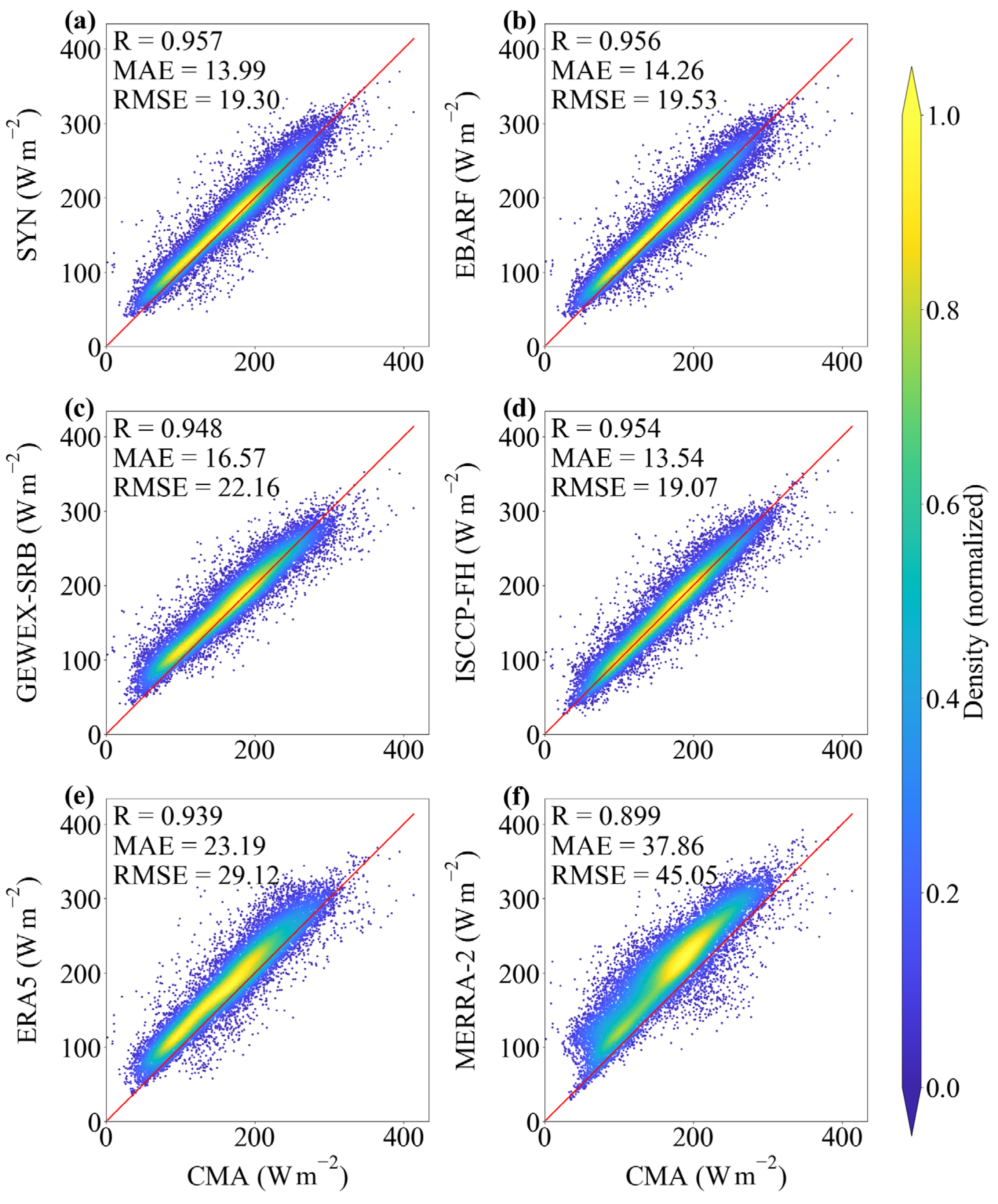
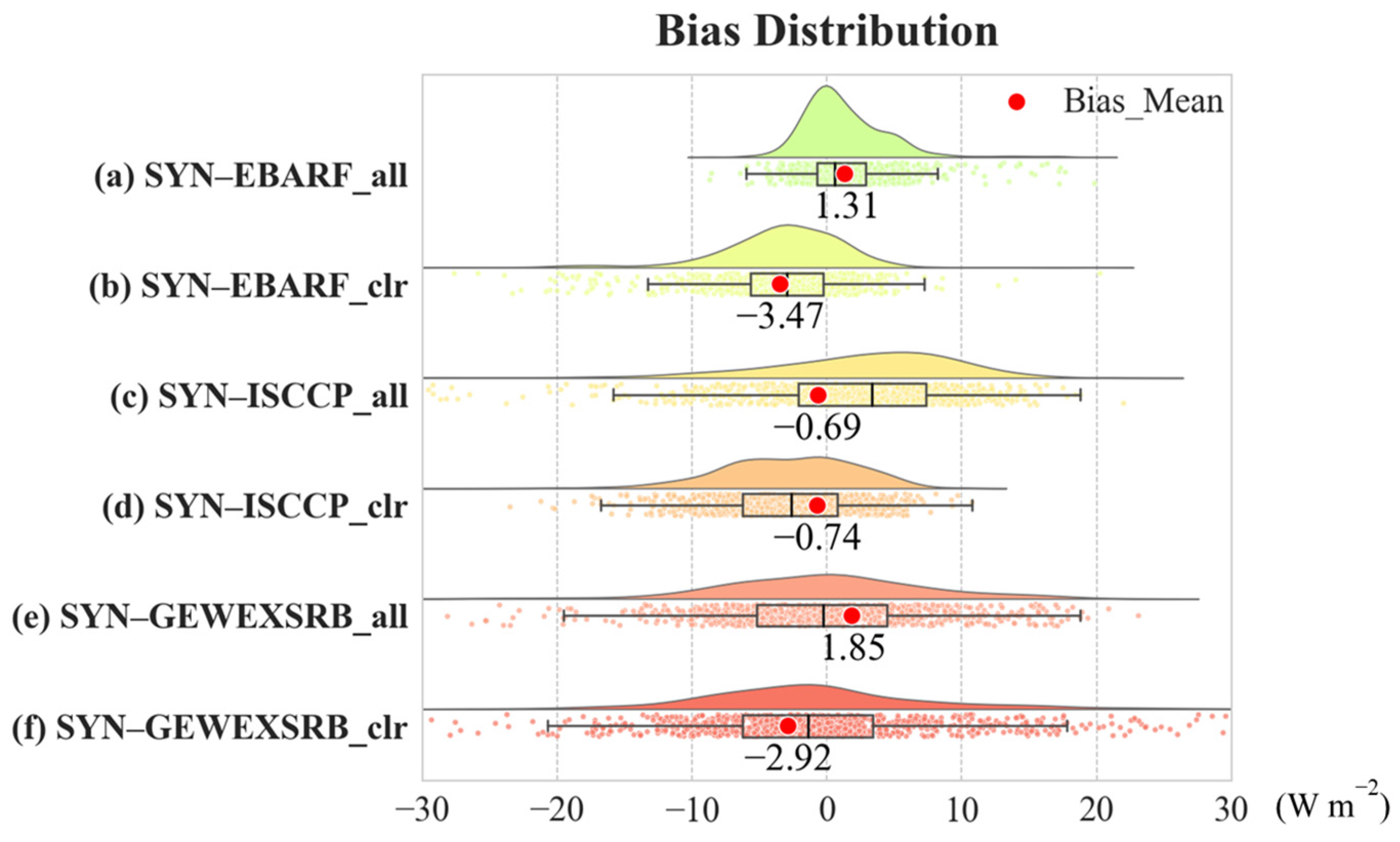
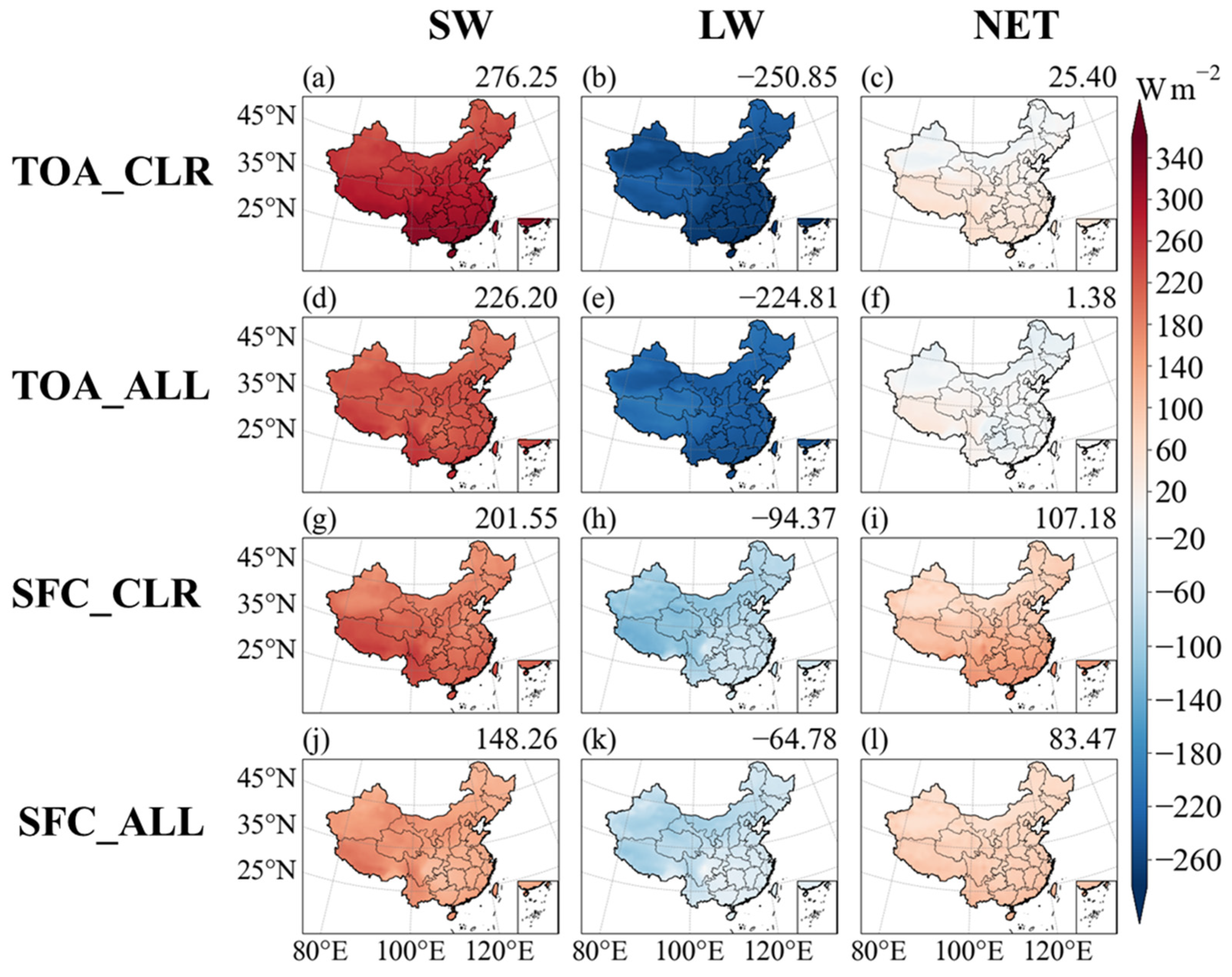
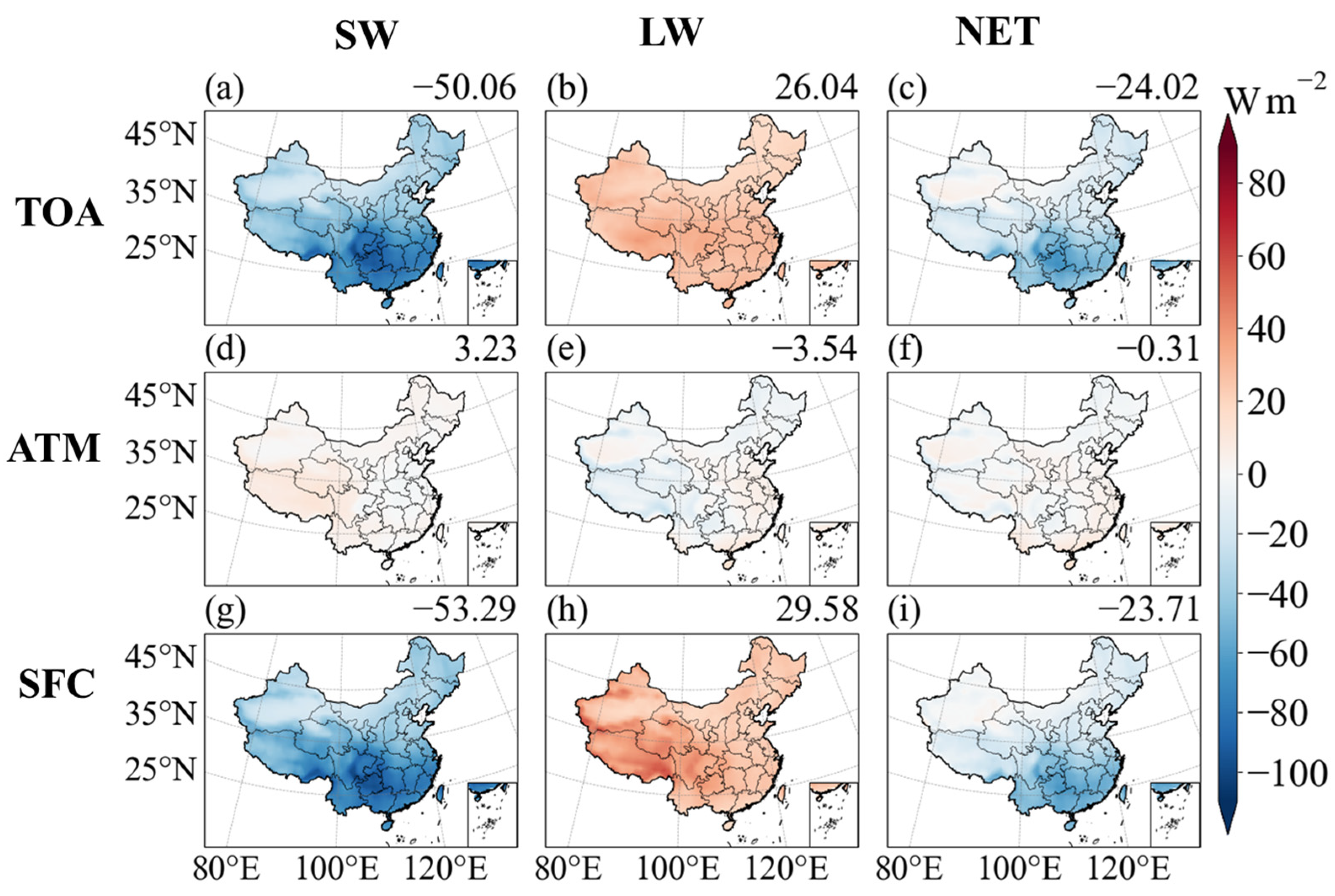
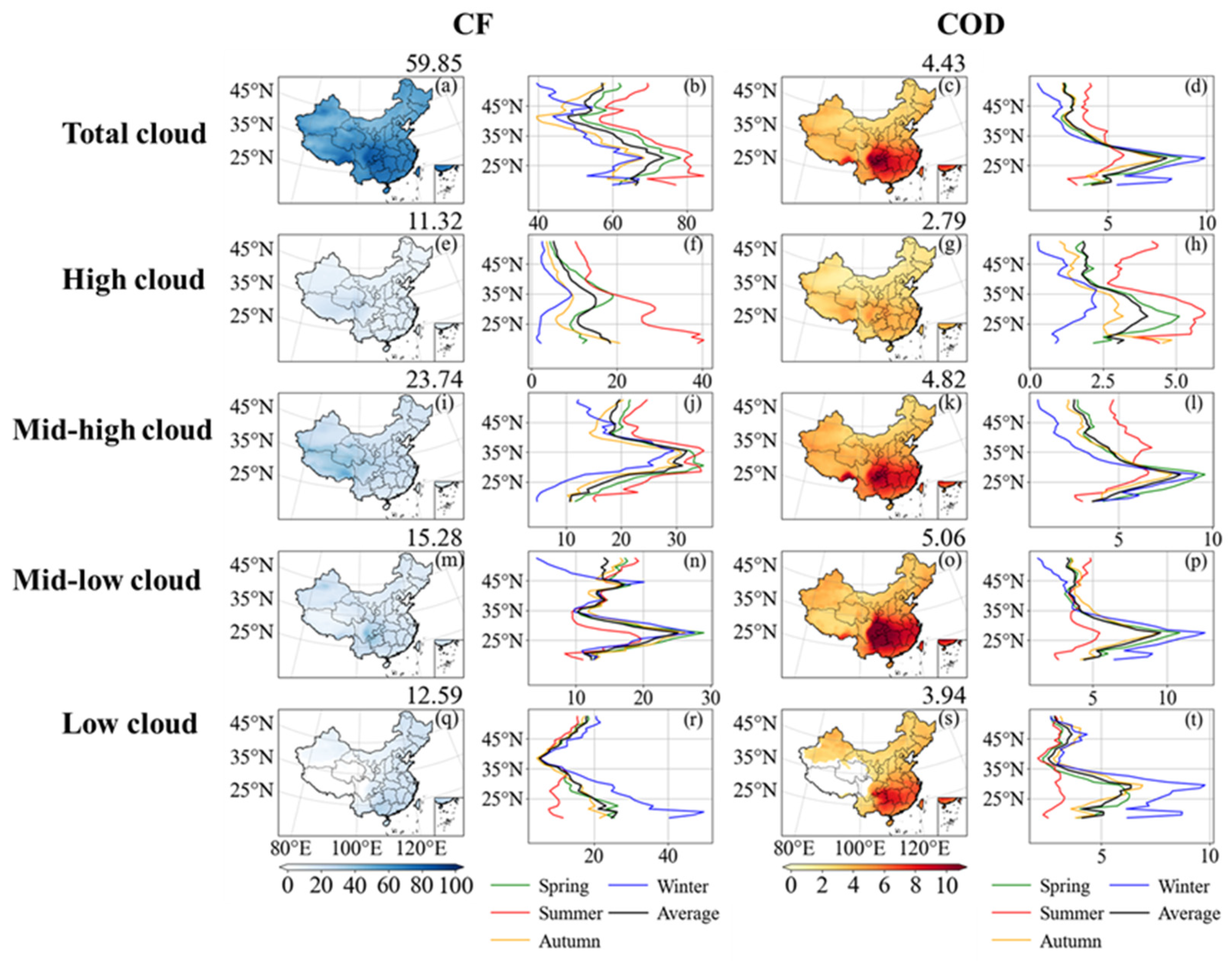
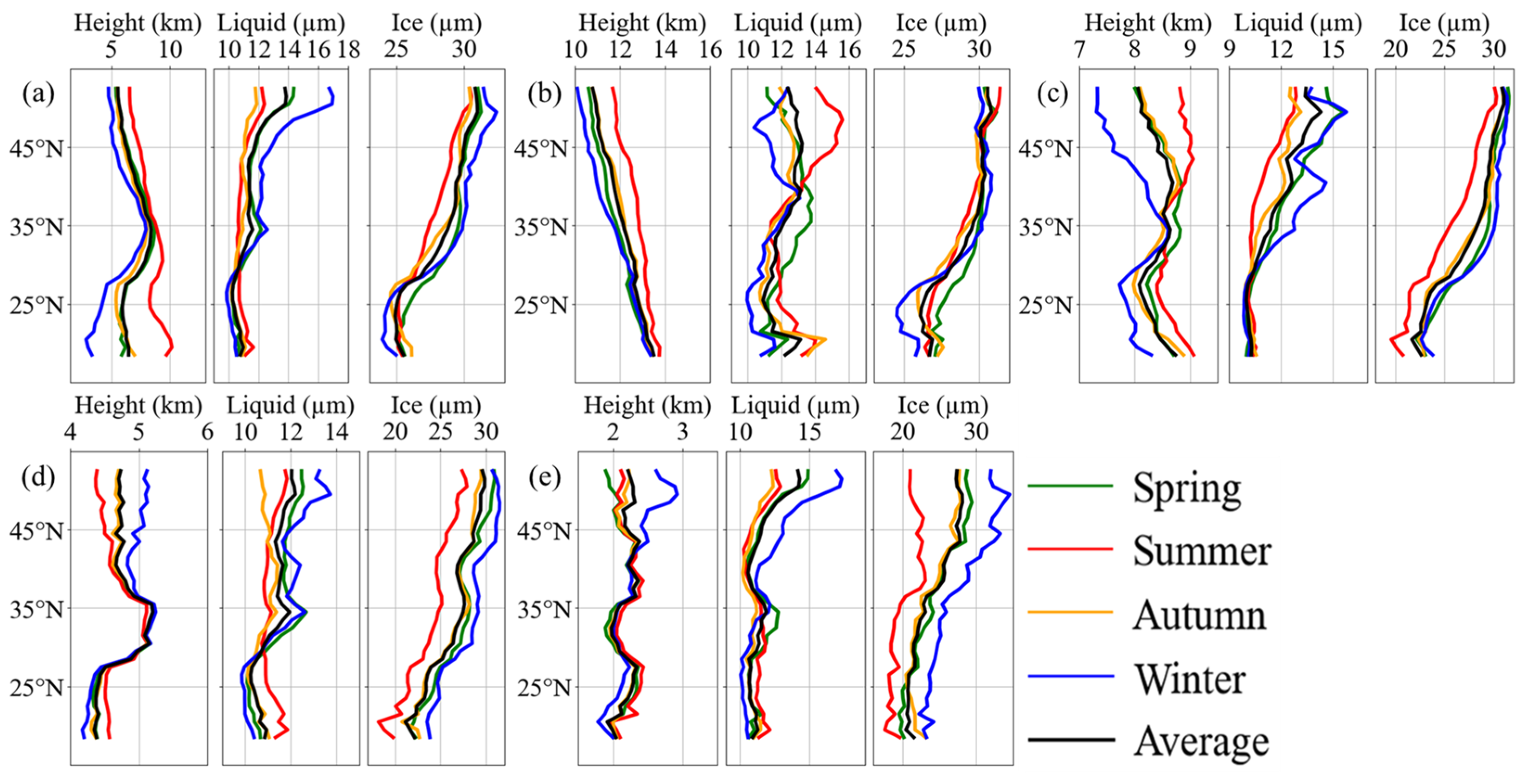
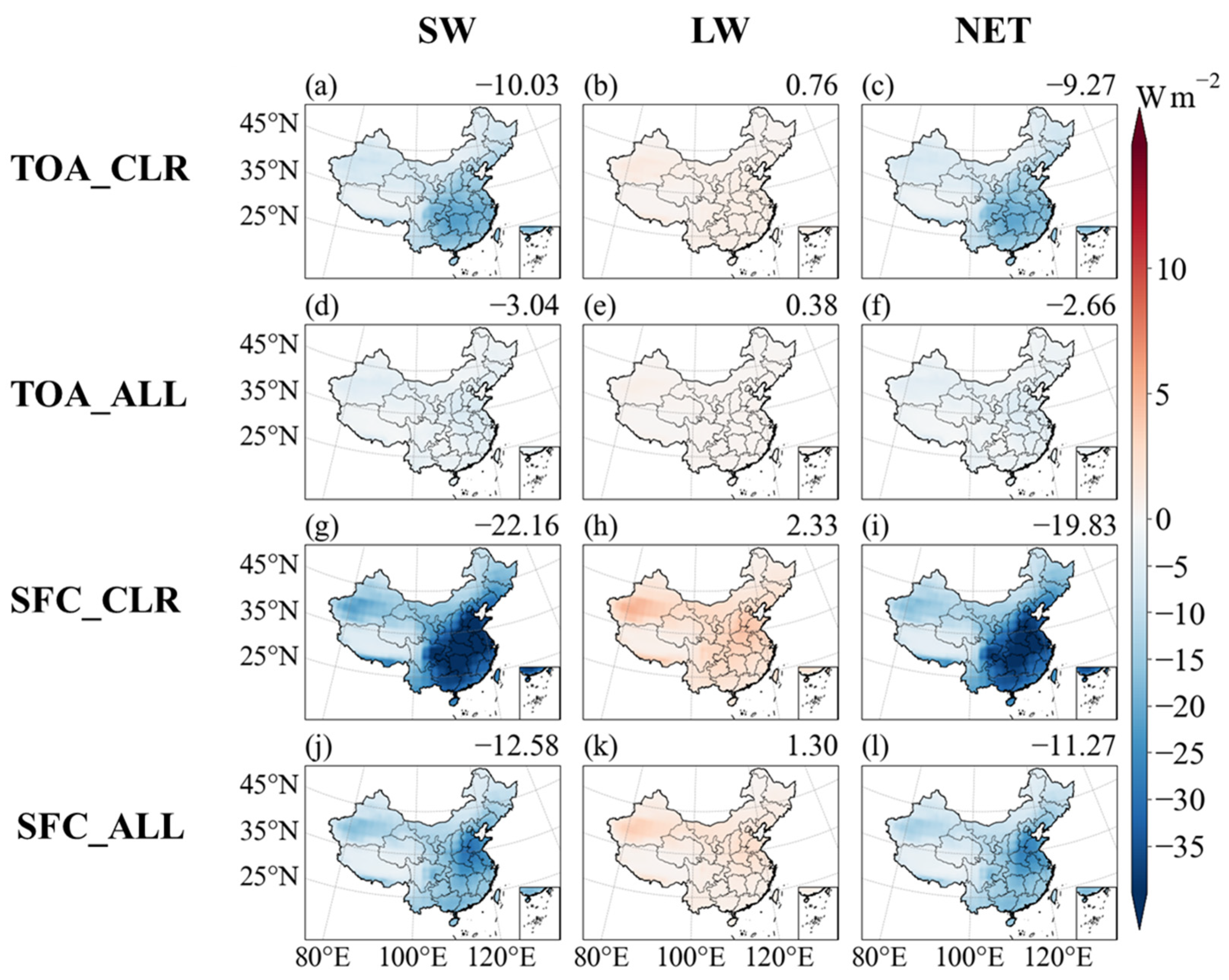
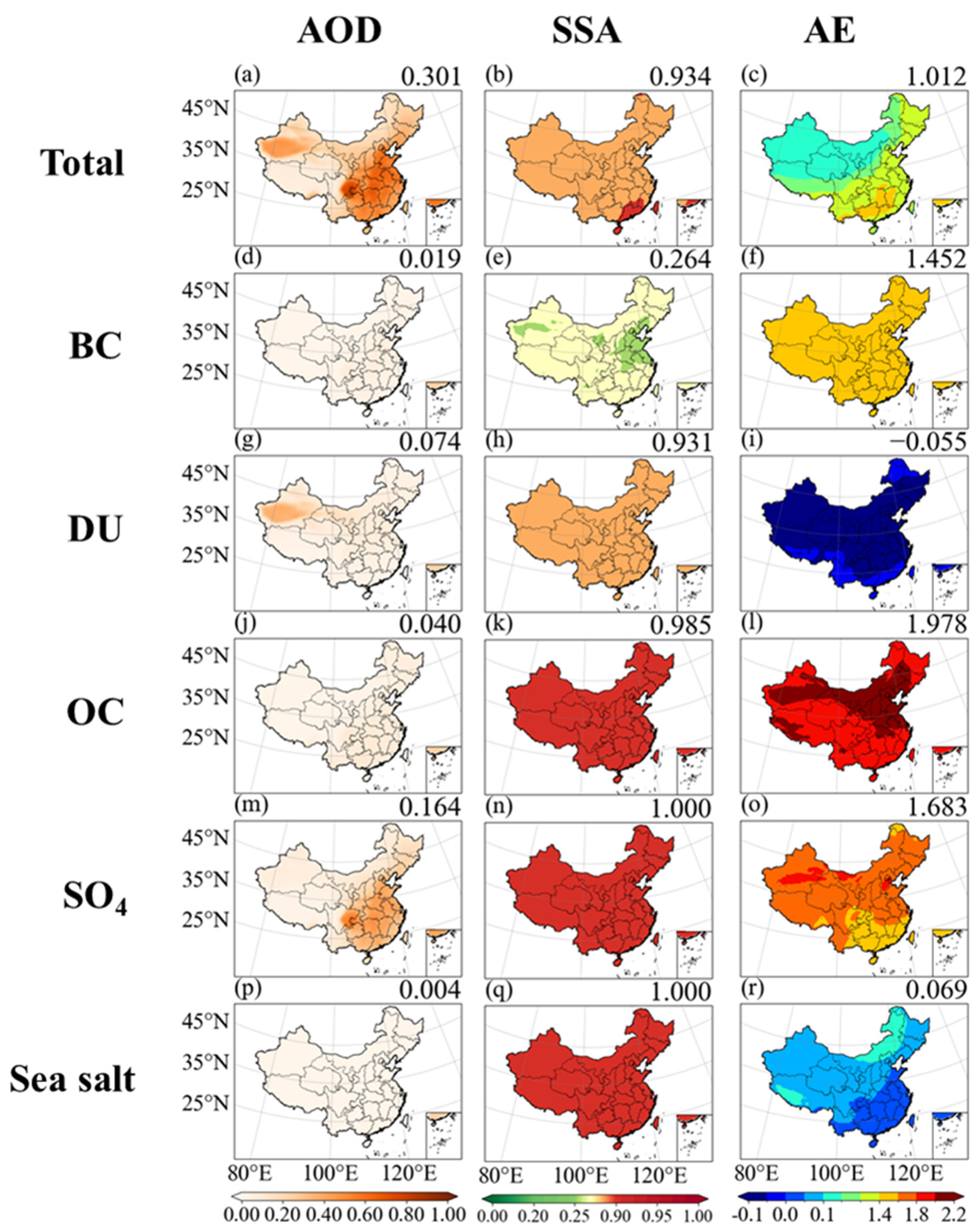
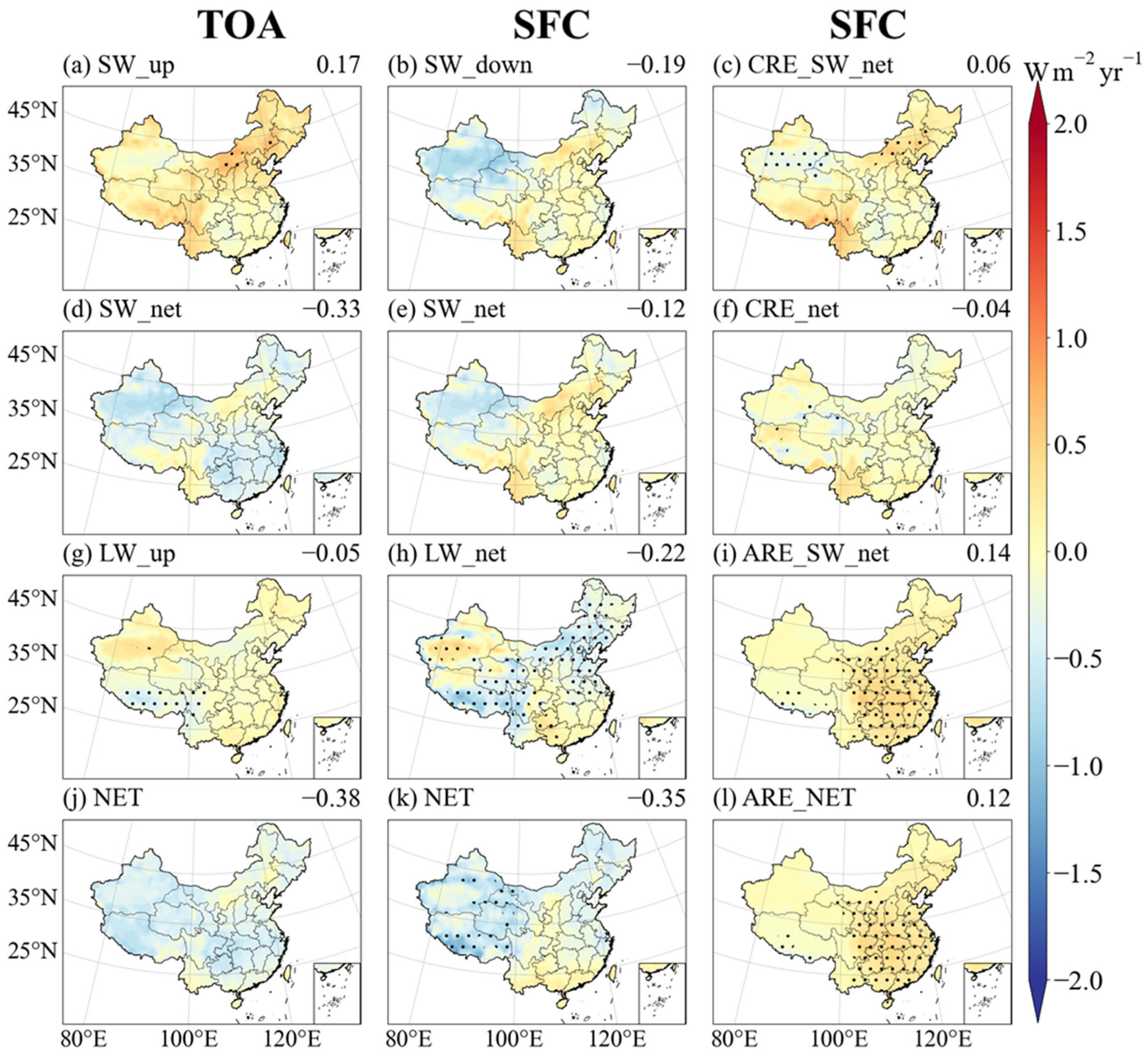
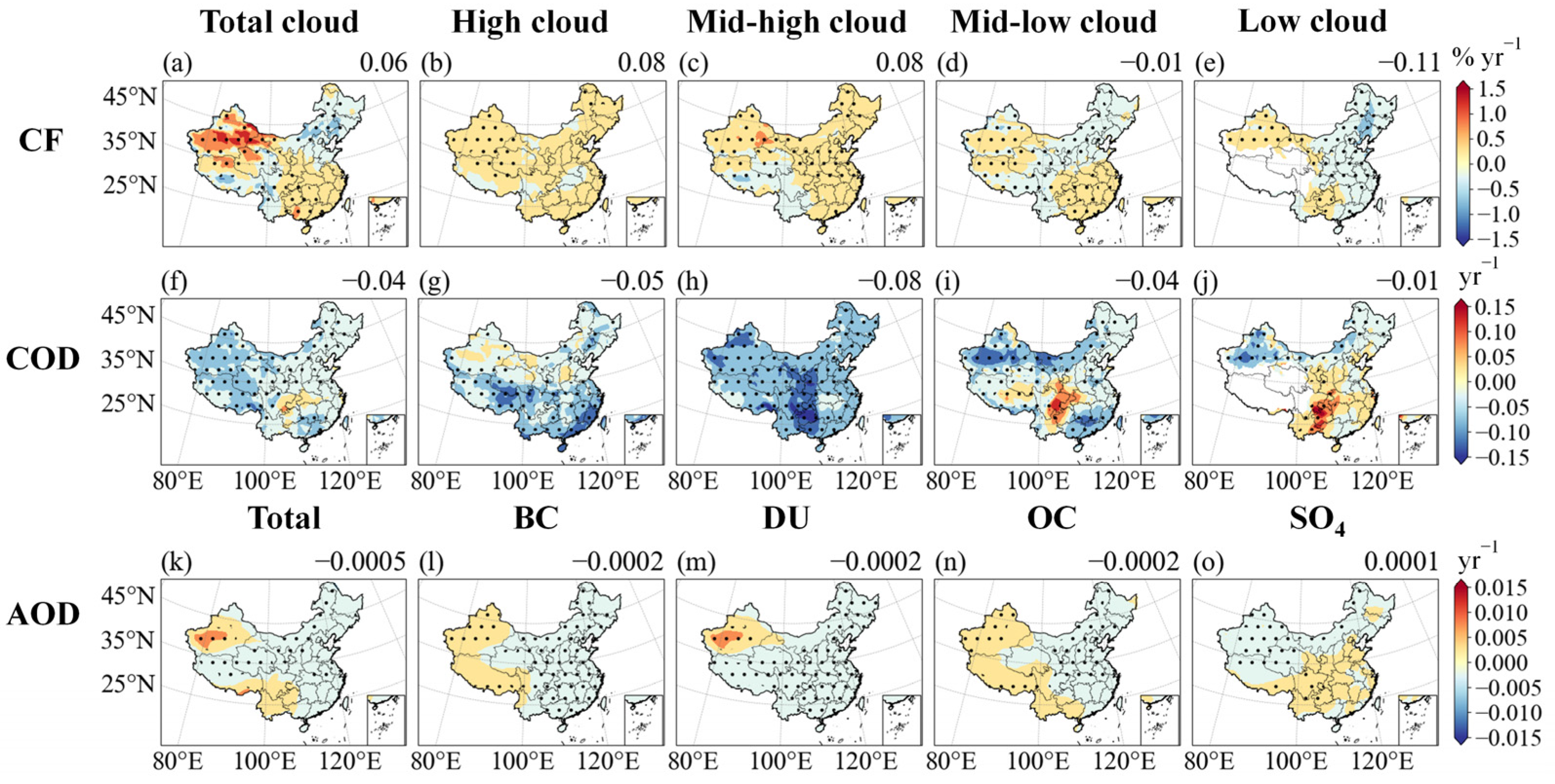
| Dataset | Available Periods | The Period in This Study | Spatial Resolution | Organization | URL |
|---|---|---|---|---|---|
| CERES-SYN | 2000–present | March 2000–February 2023 | 1° × 1° | NASA Langley Research Center (LaRC) | https://asdc.larc.nasa.gov/data/CERES/SYN1deg-Day/ (assessed on 24 December 2024) |
| CERES-EBAF | 2000–present | March 2000–February 2023 | 1° × 1° | NASA Langley Research Center (LaRC) | https://asdc.larc.nasa.gov/data/CERES/EBAF/ (assessed on 24 December 2024) |
| ISCCP-FH | 1983–2017 | March 2000–June 2016 | 1° × 1° | NASA Goddard Institute for Space Studies (GISS) | https://isccp.giss.nasa.gov/pub/flux-fh/ (assessed on 24 December 2024) |
| GEWEX-SRB | 1983–2017 | March 2000–June 2016 | 1° × 1° | Global Energy and Water Cycle Experiment (GEWEX), NASA | https://asdc.larc.nasa.gov/project/SRB (assessed on 24 December 2024) |
| MERRA-2 | 1980–present | March 2000–February 2023 | 0.5° × 0.625° | NASA Global Modeling and Assimilation Office (GMAO) | https://gmao.gsfc.nasa.gov/reanalysis/MERRA-2/ (assessed on 24 December 2024) |
| ERA5 | 1950–present | March 2000–June 2016 | 0.1° × 0.1° | European Centre for Medium-Range Weather Forecasts (ECMWF) | https://doi.org/10.24381/cds.68d2bb30 (assessed on 24 December 2024) |
| CMA | 1957–2017 | March 2000–June 2016 | Ground observation | China Meteorological Administration | http://data.cma.cn/ (assessed on 24 December 2024) |
| Region | CRE_SW (W m−2 year−1) | Total CF (% year−1) | Total COD (year−1) | Specific CF (% year−1) | ARE_SW (W m−2 year−1) | AOD (year−1) | Specific AOD (year−1) |
|---|---|---|---|---|---|---|---|
| China | 0.06 | 0.06 | −0.04 | HC (CF: 0.08, COD: −0.05), mid-HC (CF: 0.08, COD: −0.08) | 0.14 | −0.0005 | BC (−0.0002), DU (−0.0002), OC (−0.0002) |
| Inner Mongolia | 0.18 | −0.2 | −0.04 | mid-LC (CF: −0.12, COD: −0.06) | 0.12 | −0.0002 | DU (−0.00004), SO4 (−0.00004) |
| Xinjiang | −0.1 | 0.46 | −0.06 | HC (CF: 0.15, COD: −0.02) mid-HC (CF: 0.22, COD: −0.09) | 0.02 | 0.0001 | DU (0.0001) |
| Tibetan Plateau | 0.12 | −0.06 | −0.06 | mid-HC (CF:0.07, COD: −0.09) | −0.009 | −0.0003 | DU (−0.0004) |
| Northern China | 0.13 | −0.16 | −0.03 | LC (CF: −0.31, COD: −0.01) | 0.20 | −0.002 | OC (−0.001), DU (−0.001) |
| Southern China | 0.01 | 0.14 | −0.02 | mid-HC (CF: 0.07, COD: −0.09), mid-LC CF: 0.09, COD: −0.02), LC (CF: −0.08, COD: 0.03), | 0.29 | −0.0008 | OC (−0.0003), BC (−0.0004) |
Disclaimer/Publisher’s Note: The statements, opinions and data contained in all publications are solely those of the individual author(s) and contributor(s) and not of MDPI and/or the editor(s). MDPI and/or the editor(s) disclaim responsibility for any injury to people or property resulting from any ideas, methods, instructions or products referred to in the content. |
© 2025 by the authors. Licensee MDPI, Basel, Switzerland. This article is an open access article distributed under the terms and conditions of the Creative Commons Attribution (CC BY) license (https://creativecommons.org/licenses/by/4.0/).
Share and Cite
Wang, S.; Yi, B. Cloud and Aerosol Impacts on the Radiation Budget over China from 2000 to 2023. Remote Sens. 2025, 17, 1666. https://doi.org/10.3390/rs17101666
Wang S, Yi B. Cloud and Aerosol Impacts on the Radiation Budget over China from 2000 to 2023. Remote Sensing. 2025; 17(10):1666. https://doi.org/10.3390/rs17101666
Chicago/Turabian StyleWang, Shuai, and Bingqi Yi. 2025. "Cloud and Aerosol Impacts on the Radiation Budget over China from 2000 to 2023" Remote Sensing 17, no. 10: 1666. https://doi.org/10.3390/rs17101666
APA StyleWang, S., & Yi, B. (2025). Cloud and Aerosol Impacts on the Radiation Budget over China from 2000 to 2023. Remote Sensing, 17(10), 1666. https://doi.org/10.3390/rs17101666






